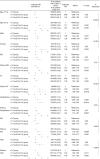Association of the low e' and high E/e' with long-term outcomes in patients with normal ejection fraction: a hospital population-based observational cohort study
- PMID: 31753896
- PMCID: PMC6887062
- DOI: 10.1136/bmjopen-2019-032663
Association of the low e' and high E/e' with long-term outcomes in patients with normal ejection fraction: a hospital population-based observational cohort study
Abstract
Objective: We aimed to evaluate the association of the severity of left ventricular (LV) diastolic dysfunction with long-term outcomes in patients with normal ejection fraction.
Design: Retrospective study.
Setting: A single centre in Japan.
Participants: We included 3576 patients who underwent both scheduled transthoracic echocardiography and ECG between 1 January and 31 December 2013, in a hospital-based population after excluding valvular diseases or low ejection fraction (<50%) or atrial fibrillation and categorised them into three groups: septal tissue Doppler early diastolic mitral annular velocity (e')≥7 (without relaxation disorder, n=1593), e'<7 and early mitral inflow velocity (E)/e'≤14 (with relaxation disorder and normal LV end-diastolic pressure, n=1337) and e'<7 and E/e'>14 (with relaxation disorder and high LV end-diastolic pressure, n=646).
Primary and secondary outcome measures: The primary outcome measure was a composite of all-cause death and major adverse cardiac events (MACE). The secondary outcome measure were all-cause death and MACE, separately.
Results: The cumulative 3-year incidences of the primary outcome measures were significantly higher in the e'<7 and E/e'≤14 (19.0%) and e'<7 and E/e'>14 group (23.4%) than those for the e'≥7 group (13.0%; p<0.001). After adjusting for confounders, the excess 3-year risk of primary outcome for the groups with e'<7 and E/e'≤14 related to e'≥7 (HR: 1.24; 95% CI 1.02 to 1.52) and e'<7 and E/e'>14 related to e'<7 (HR: 1.57; 95% CI 1.28 to 1.94) were significant. The severity of diastolic dysfunction was associated with incrementally higher risk for primary outcomes (p<0.001).
Conclusion: The severity of LV diastolic dysfunction using e'<7 and E/e'>14 was associated with the long-term prognosis in patients with normal ejection fraction in an incremental fashion.
Keywords: cardiology; diastolic dysfunction; echocardiography; preserved ejection fraction; retrospective.
© Author(s) (or their employer(s)) 2019. Re-use permitted under CC BY-NC. No commercial re-use. See rights and permissions. Published by BMJ.
Conflict of interest statement
Competing interests: None declared.
Figures



Similar articles
-
Tissue Doppler index, E/E', and ischemic stroke in patients with atrial fibrillation and preserved left ventricular ejection fraction.J Neurol Sci. 2008 Aug 15;271(1-2):148-52. doi: 10.1016/j.jns.2008.04.006. Epub 2008 May 22. J Neurol Sci. 2008. PMID: 18501379
-
Triphasic mitral inflow velocity with mid-diastolic flow: the presence of mid-diastolic mitral annular velocity indicates advanced diastolic dysfunction.Eur J Echocardiogr. 2006 Jan;7(1):16-21. doi: 10.1016/j.euje.2005.03.007. Eur J Echocardiogr. 2006. PMID: 16378917
-
Different prognostic impact of the tissue Doppler-derived E/e' ratio on mortality in Chagas cardiomyopathy patients with heart failure.J Heart Lung Transplant. 2012 Jun;31(6):634-41. doi: 10.1016/j.healun.2012.01.865. Epub 2012 Feb 1. J Heart Lung Transplant. 2012. PMID: 22305956
-
Association of weaning failure from mechanical ventilation with transthoracic echocardiography parameters: a systematic review and meta-analysis.Br J Anaesth. 2021 Jan;126(1):319-330. doi: 10.1016/j.bja.2020.07.059. Epub 2020 Sep 25. Br J Anaesth. 2021. PMID: 32988600
-
Left ventricular diastolic dysfunction in non-myocardial disorders.Eur Heart J Cardiovasc Imaging. 2024 Oct 30;25(11):1554-1565. doi: 10.1093/ehjci/jeae209. Eur Heart J Cardiovasc Imaging. 2024. PMID: 39172598 Free PMC article. Review.
Cited by
-
Discrepancy between left ventricular hypertrophy by echocardiography and electrocardiographic hypertrophy: clinical characteristics and outcomes.Open Heart. 2021 Sep;8(2):e001765. doi: 10.1136/openhrt-2021-001765. Open Heart. 2021. PMID: 34556560 Free PMC article.
-
Prognostic power of conventional echocardiography in individuals without history of cardiovascular diseases: A systematic review and meta-analysis.Clinics (Sao Paulo). 2021 Jun 28;76:e2754. doi: 10.6061/clinics/2021/e2754. eCollection 2021. Clinics (Sao Paulo). 2021. PMID: 34190849 Free PMC article.
-
Clinical impact of left and right axis deviations with narrow QRS complex on 3-year outcomes in a hospital-based population in Japan.Sci Rep. 2021 Apr 26;11(1):8892. doi: 10.1038/s41598-021-88259-8. Sci Rep. 2021. PMID: 33903653 Free PMC article.
-
Tissue Doppler Imaging in Acute and Critical Care: Enhancing Diagnostic Precision.Medicina (Kaunas). 2025 Jun 6;61(6):1051. doi: 10.3390/medicina61061051. Medicina (Kaunas). 2025. PMID: 40572739 Free PMC article. Review.
-
hsa-miR-548v controls the viscoelastic properties of human cardiomyocytes and improves their relaxation rates.JCI Insight. 2024 Jan 2;9(3):e161356. doi: 10.1172/jci.insight.161356. JCI Insight. 2024. PMID: 38165745 Free PMC article.
References
-
- Nagueh SF, Smiseth OA, Appleton CP, et al. . Recommendations for the Evaluation of Left Ventricular Diastolic Function by Echocardiography: An Update from the American Society of Echocardiography and the European Association of Cardiovascular Imaging. J Am Soc Echocardiogr 2016;29:277–314. 10.1016/j.echo.2016.01.011 - DOI - PubMed
-
- Ommen SR, Nishimura RA, Appleton CP, et al. . Clinical utility of Doppler echocardiography and tissue Doppler imaging in the estimation of left ventricular filling pressures: a comparative simultaneous Doppler-catheterization study. Circulation 2000;102:1788–94. 10.1161/01.cir.102.15.1788 - DOI - PubMed
Publication types
MeSH terms
LinkOut - more resources
Full Text Sources
Other Literature Sources
Medical
